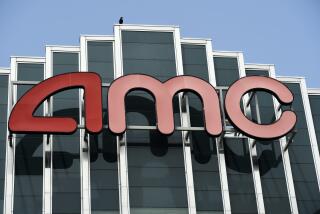Debt Cripples Leveraged Buyout of AME : Borrowing: The Burbank video post-production company has been unable to make payments on the money used to go private. Now the firm is for sale.
- Share via
Want a prime example of how the corporate leveraged-buyout craze went overboard in the late 1980s? Look no further than Burbank, home of AME Inc.
AME, built by founder Andrew M. McIntyre into the largest video post-production house serving Hollywood’s studios, went private in 1989 when an investor group bought the company for $108.5 million--most of it leveraged, or borrowed.
Today AME is up for sale because it hasn’t been able to service that debt for more than a year and its largest creditor, First National Bank of Boston, wants to recover at least part of the $62 million that it loaned in the leveraged buyout.
The transaction “went into stress in the first three months” after the deal was signed, said Alfred J. Moran Jr. of Kibel, Green Inc., a Santa Monica crisis-management firm that has been hired by AME to assist in its sale.
The deal assumed that AME would have to generate $21 million a year in earnings before depreciation, taxes and interest--a sum also called pretax cash flow--to cover the leveraged-buyout debt, Moran said. Yet the company had never generated more than $10 million, he said.
AME early on did manage to pare the debt to $96.5 million, but that’s all. Even renowned studio executive Dennis Stanfill, who was AME’s chief executive from mid-1990 until he resigned on Dec. 31 to help lead the MGM-Pathe Communications Co. studio, was unable to solve AME’s debt problem.
AME thus became a casualty of the waning days of the leveraged-buyout wave, when bidders overpaid by plenty and lenders provided the cash despite the companies’ doubtful ability to repay.
The company employs 430 people and mainly transfers movie and television films to videotape so they can be distributed to the public via videocassettes, cable TV and foreign broadcast.
First National Bank of Boston could now theoretically try to close and liquidate the company. But AME’s current president, Jan A. Yarbrough, said: “The bank supports a sale. They have no intention of closing our doors.”
Moran said the bank has no incentive to close AME, which posted revenue of $51 million last year. Nine suitors have made bids, ranging from $10 million to $25 million. The bids “are already higher than the liquidation value of the company,” he said. “So the bank has every desire to wait for the sale.” AME officials declined to name the suitors.
A sale will not make everyone happy. Whoever buys the company will not assume AME’s existing debt, Moran said. That means First National would get less than 50 cents on each dollar it loaned.
It is up to First National to decide whether any of the other leveraged-buyout lenders--notably Westinghouse Electric Corp.’s credit unit, which loaned $33.5 million in the deal--will get a penny, he said. That’s because Westinghouse’s debt was subordinate to First National’s senior debt in terms of repayment.
“If they get money, it’s because First National Bank of Boston wants them to have money, not because they have any right,” he said.
What about the investor group? The group, led by an investor named Lawrence J. Berkowitz, lost everything in AME because its equity was effectively wiped out by “the vast amount of debt,” Moran said.
So it appears that the only big winner was McIntyre, a brash entrepreneur who started AME in 1980 with $90,000 and reaped $22 million when it was sold.
McIntyre, in fact, now wants to buy the company back. In November he offered $25 million before AME formally put itself on the block.
McIntyre said AME has ignored his offer. “They never responded to it and still haven’t,” he said.
Yarbrough, an 11-year AME veteran, said McIntyre “as of this hour has not presented himself as a qualified potential buyer.” Yarbrough declined to elaborate, and McIntyre said the issue has not been explained to him either.
“Maybe someone would care to tell me how I can become qualified. I’d be willing to listen,” McIntyre said. He added that, because months have passed since his initial bid, he might reduce his offer.
In the meantime, there’s a legal dispute between AME and McIntyre. McIntyre says if AME is sold to a third party, an agreement he signed when he left AME in which he promised not to compete entitles him to enter that business. In other words, he could jump back into video post-production as a rival to AME if AME were sold to someone else.
AME, however, contends that the “non-compete agreement transfers with the sale,” Moran said, noting that McIntyre also got $2 million for signing the deal.
In any case, the comments by Moran and Yarbrough are a big change for AME, whose executives had refused virtually all requests for public statements since the leveraged buyout.
More to Read
The biggest entertainment stories
Get our big stories about Hollywood, film, television, music, arts, culture and more right in your inbox as soon as they publish.
You may occasionally receive promotional content from the Los Angeles Times.











